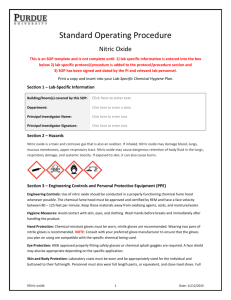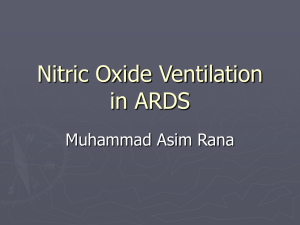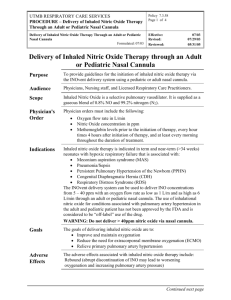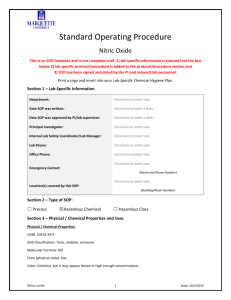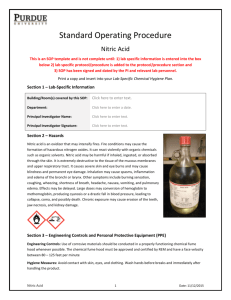Operating Instructions for Inhaled Nitric Oxide Therapy With
advertisement
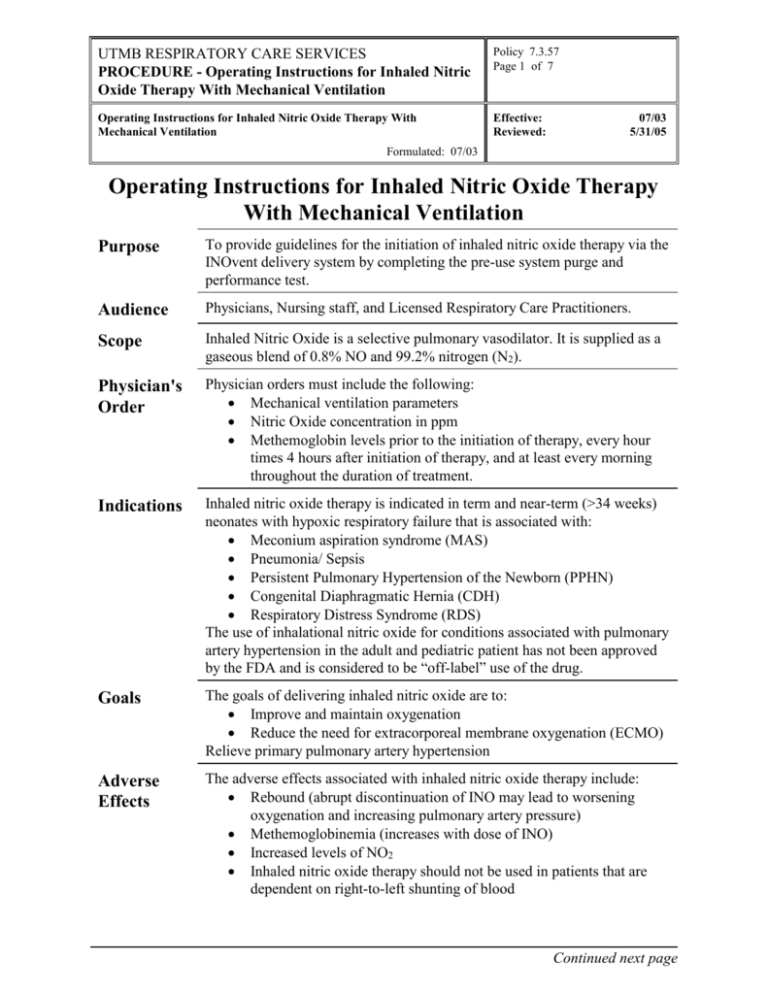
UTMB RESPIRATORY CARE SERVICES PROCEDURE - Operating Instructions for Inhaled Nitric Oxide Therapy With Mechanical Ventilation Policy 7.3.57 Page 1 of 7 Operating Instructions for Inhaled Nitric Oxide Therapy With Mechanical Ventilation Effective: Reviewed: 07/03 5/31/05 Formulated: 07/03 Operating Instructions for Inhaled Nitric Oxide Therapy With Mechanical Ventilation Purpose To provide guidelines for the initiation of inhaled nitric oxide therapy via the INOvent delivery system by completing the pre-use system purge and performance test. Audience Physicians, Nursing staff, and Licensed Respiratory Care Practitioners. Scope Inhaled Nitric Oxide is a selective pulmonary vasodilator. It is supplied as a gaseous blend of 0.8% NO and 99.2% nitrogen (N2). Physician's Order Physician orders must include the following: Mechanical ventilation parameters Nitric Oxide concentration in ppm Methemoglobin levels prior to the initiation of therapy, every hour times 4 hours after initiation of therapy, and at least every morning throughout the duration of treatment. Indications Inhaled nitric oxide therapy is indicated in term and near-term (>34 weeks) neonates with hypoxic respiratory failure that is associated with: Meconium aspiration syndrome (MAS) Pneumonia/ Sepsis Persistent Pulmonary Hypertension of the Newborn (PPHN) Congenital Diaphragmatic Hernia (CDH) Respiratory Distress Syndrome (RDS) The use of inhalational nitric oxide for conditions associated with pulmonary artery hypertension in the adult and pediatric patient has not been approved by the FDA and is considered to be “off-label” use of the drug. Goals The goals of delivering inhaled nitric oxide are to: Improve and maintain oxygenation Reduce the need for extracorporeal membrane oxygenation (ECMO) Relieve primary pulmonary artery hypertension Adverse Effects The adverse effects associated with inhaled nitric oxide therapy include: Rebound (abrupt discontinuation of INO may lead to worsening oxygenation and increasing pulmonary artery pressure) Methemoglobinemia (increases with dose of INO) Increased levels of NO2 Inhaled nitric oxide therapy should not be used in patients that are dependent on right-to-left shunting of blood Continued next page UTMB RESPIRATORY CARE SERVICES PROCEDURE - Operating Instructions for Inhaled Nitric Oxide Therapy With Mechanical Ventilation Policy 7.3.57 Page 2 of 7 Operating Instructions for Inhaled Nitric Oxide Therapy With Mechanical Ventilation Effective: Reviewed: 07/03 5/31/05 Formulated: 07/03 Equipment Procedure 1 - INOvent delivery system 2 - Full NO cylinders 1 - Siemens Servo 300 or Newport Breeze mechanical ventilator 1 - Adult, pediatric, infant, or neonatal manual resuscitation bag Refer to the appropriate equipment manual for assembly instructions. Pre-Use System Purge and Performance Test Step Action 1 Turn the INOvent delivery system ON and confirm that both the buzzer and speaker sound. 2 With the INOvent system ON, turn each cylinder valve ON and then OFF. Check for adequate cylinder pressures. Wait 30 seconds and check for pressure decrease (indicating leak in system) 3 Assemble Injector Module for system purge and performance test. See Appendix I. 4 Perform low range calibration of the NO, NO2, and O2 monitors. 5 Set the oxygen flow to 15 L/min and set the NO concentration to its maximum setting. 6 Ensure that the cylinder pressure drops and that the Low NO/N2 pressure and Delivery Failure alarms sound. 7 Turn on the NO cylinder that will be used to initiate therapy. 8 With O2 running at 15 L/min, set the NO to 40 ppm. 9 Wait 3 minutes or until monitor readings are stable for the following: O2 – 95% NO2 (max) – 1.5 NO ppm (min/max) – 32/48 Continued next page UTMB RESPIRATORY CARE SERVICES PROCEDURE - Operating Instructions for Inhaled Nitric Oxide Therapy With Mechanical Ventilation Policy 7.3.57 Page 3 of 7 Operating Instructions for Inhaled Nitric Oxide Therapy With Mechanical Ventilation Effective: Reviewed: 07/03 5/31/05 Formulated: 07/03 Procedure Continued Manual NO Delivery System Purge and Performance Test Step Action 1 Connect green O2 hose (50 psi) to the flow meter outlet and to the INOvent delivery system at the O2 inlet connector. 2 Connect the black O2 hose (50 psi) to the back of the flow meter manifold and then to a 50-psi wall or cylinder O2 source. 3 Connect the O2 tubing from the manual resuscitator bag with O2 reservoir to the NO/O2 output connector on the back of the INOvent delivery system. 4 Disconnect the O2 tubing from the resuscitator bag and connect a 15M x 4.5 mm adapter with a sample tee. 5 Attach sample line to the sample tee. 6 Turn flow meter to 15 L/min and ensure that the float moves to the middle of the NO Flow Indicator Window. 7 Ensure that NO reading is 20 + 8 ppm and the NO2 reading is less than 1.0 ppm. 8 Reduce O2 flow to 1 L/min. Ensure that float drops to the bottom of the NO flow indicator. Set O2 flow to zero and disconnect sample tee and 15 M x 4.5mm adapter from the O2 tubing. Reconnect the resuscitator bag to the oxygen tubing. 9 2 Connect the black O2 hose (50 psi) to the back of the flow meter manifold and then to a 50-psi wall or cylinder O2 source. Initiation of Therapy with Conventional Mechanical Ventilation Step 1 Action Obtain arterial blood gas analysis of methemoglobin level prior to the initiation of therapy. Continued next page UTMB RESPIRATORY CARE SERVICES PROCEDURE - Operating Instructions for Inhaled Nitric Oxide Therapy With Mechanical Ventilation Policy 7.3.57 Page 4 of 7 Operating Instructions for Inhaled Nitric Oxide Therapy With Mechanical Ventilation Effective: Reviewed: 07/03 5/31/05 Formulated: 07/03 Procedure Continued Initiation of Therapy with Conventional Mechanical Ventilation Step Action 2 Ensure that a purge has been completed within 5 minutes of the start of therapy. If not, repeat the performance test as outlined above and ensure that the NO2 level is less than the values listed for the cylinder being used. 3 Position the injector module on the dry side of the humidifier chamber, noting the airflow direction arrow on the module. The injector module should not be placed directly off of the ventilator in ensure accurate flow measurements. 4 Connect 6” extension tubing from the patient wye on the inspiratory side of the breathing circuit to the sample tee, distal to the temperature probe adapter. This extension tubing minimizes sampling of mixed inspiratory/ expiratory gases. See Appendix II. 5 Ensure that trigger sensitivity is set appropriately to prevent auto-cycling, as the INOvent system subtracts gas from the breathing circuit and can affect the sensitivity of flowtriggered breaths. 6 After connecting the INOvent delivery system to the patient circuit, push the Set NO button and turn the control wheel clockwise to increase the NO concentration or counterclockwise to decrease the concentration. Push either the Set NO button or the control wheel to confirm the set concentration. NOTE: NO delivery dilutes the therapy gas O2 concentration up to 10% depending upon the set NO concentration. 7 After the monitored values have stabilized, set or change the user-adjustable alarms to the appropriate ranges. O2 alarms should be set + 5% of desired FiO2 NO2 high alarm should be set at 3.0 ppm NO alarms should be set + 5 ppm of desired level Continued next page UTMB RESPIRATORY CARE SERVICES PROCEDURE - Operating Instructions for Inhaled Nitric Oxide Therapy With Mechanical Ventilation Policy 7.3.57 Page 5 of 7 Operating Instructions for Inhaled Nitric Oxide Therapy With Mechanical Ventilation Effective: Reviewed: 07/03 5/31/05 Formulated: 07/03 Procedure Continued Initiation of Therapy with Conventional Mechanical Ventilation Step Assessment of Outcome Action 8 Methemoglobin levels should be drawn one hour after the initiation of therapy and checked q1 times four hours to monitor for increases in methemoglobin. 9 A low range calibration of sensors needs to be completed daily throughout the duration of therapy. Push the calibration button to reach the first Calibration menu. Highlight the Low Range (room air) NO, NO2, O2 option. Push the control wheel to start the low range calibration. All three sensors will calibrate automatically at the same time. Arterial, venous and capillary blood gas values Pulse oximetry Pulmonary artery pressures Infection Control Follow procedures as outlined Healthcare Epidemiology Policies and Procedures: #2.24 Respiratory Care Services. http://www.utmb.edu/policy/hcepidem/search/02-24.pdf Safety Precautions Oxygen safety techniques as outlined in section 3.6 of the INOvent Manual will be followed. All alarms on ventilators will be activated at all times. All alarms on INOvent delivery system will be activated at all times. References Sensormedics High Frequency Oscillatory Ventilator Operating Manual. Whitaker, K., Comprehensive Perinatal and Pediatric Respiratory Care, Delmar, Albany, New York, 2001. Cornfield DN, Abman SH. Inhalational nitric oxide in pulmonary parenchymal and vascular disease. Journal of Laboratory Clinical Medicine 1996 Jun; 127(6): 530-539. Miller CL. Nitric oxide therapy for the persistent pulmonary hypertension of the newborn. Neonatal Network 1995 Dec; 14(8): 9-15. Angelucci P. A new weapon against ARDS…adult respiratory distress syndrome. RN 1996 Nov; 59(11): 22-25. Continued next page UTMB RESPIRATORY CARE SERVICES PROCEDURE - Operating Instructions for Inhaled Nitric Oxide Therapy With Mechanical Ventilation Policy 7.3.57 Page 6 of 7 Operating Instructions for Inhaled Nitric Oxide Therapy With Mechanical Ventilation Effective: Reviewed: 07/03 5/31/05 Formulated: 07/03 Appendix I. System Purge and performance test WARNING: Make sure a purge has been completed within five minutes before the start of NO therapy. If not, repeat the performance test as described here, making sure this is less than the value listed for the cylinder concentration being used. 1. Connect the Injector Module to an O2 auxiliary flow meter using O2 tubing, a 4.5 mm to 15 mm adapter and a breathing circuit adapter to condition the flow before the Injector Module. See figure 5-1. 2. Connect the sample line to the outlet of the injector module with 300 mm of 22 mm hose to ensure gas mixing prior to gas sampling (see figure 5-1). Attach a sampling line from the sample tee to the sample connector on the front panel. 1. 2. 3. 4. 5. 6. 7. 8. 9. O2 Flow meter O2 Tubing 15 mm x 4.5 mm Adapter Injector Module 300 mm of 22 mm hose Sample Tee Inspiratory Gas Sample Line NO/N2 Injector Tube Injector Module Electrical Cable Continued next page UTMB RESPIRATORY CARE SERVICES PROCEDURE - Operating Instructions for Inhaled Nitric Oxide Therapy With Mechanical Ventilation Policy 7.3.57 Page 7 of 7 Operating Instructions for Inhaled Nitric Oxide Therapy With Mechanical Ventilation Effective: Reviewed: Formulated: 07/03 Appendix II. 07/03 5/31/05
